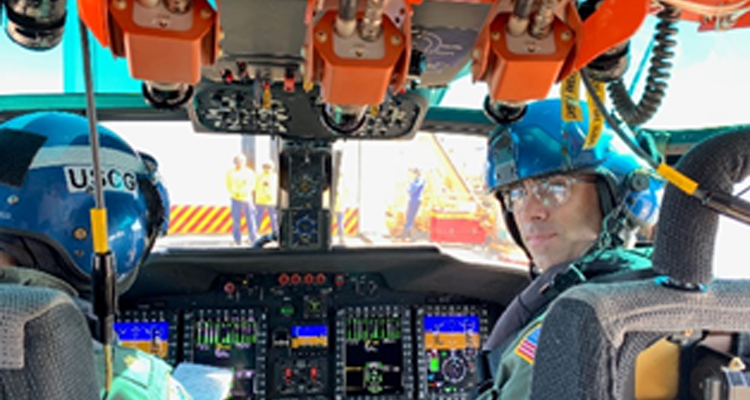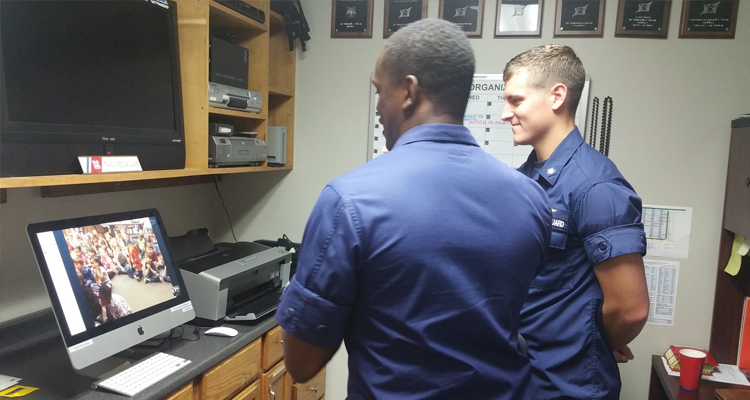June 4, 2020 —

The Coast Guard honored a group of exceptional innovators with Capt. Niels P. Thomsen Innovation Awards in a virtual ceremony June 4, 2020. The awards were presented by the commandant of the Coast Guard, Adm. Karl Schultz; Master Chief Petty Officer of the Coast Guard Jason Vanderhaden; and Rear Adm. Joseph Vojvodich, deputy commandant for mission support - deputy for materiel readiness and co-chair of the Coast Guard Innovation Council. U.S. Coast Guard photos by PA2 Travis Magee.
The Coast Guard honored a group of exceptional innovators whose ideas have helped make the Coast Guard more ready, relevant and responsive with Capt. Niels P. Thomsen Innovation Awards in a virtual award ceremony today.
The awards – named after the Coast Guard innovator who in the 1950s invented the buoy chain stopper, which dramatically improved the safety of buoy tending operations – are presented in the areas of Science and Technology; Operations and Readiness; Administration, Training and Support; Management; and Culture Change. The awards also included an Auxiliary Achievement Award to recognize the efforts of the Coast Guard Auxiliary. The awards were presented by the commandant of the Coast Guard, Adm. Karl Schultz; Master Chief Petty Officer of the Coast Guard Jason Vanderhaden; and Rear Adm. Joseph Vojvodich, deputy commandant for mission support - deputy for materiel readiness and co-chair of the Coast Guard Innovation Council.
During the ceremony, Schultz spoke about the service’s commitment to seeking and implementing innovative ideas. “Our workforce-at-large can now submit an idea with a click of the mouse. That’s how serious we are about seeking creative ideas to advance our Coast Guard,” he said, noting the 450 innovative ideas submitted through the service’s crowdsourcing platform, CG_Ideas@Work, in 2019. “Congratulations to our 2019 award winners who dared to think creatively and submit their idea or invention to advance our Coast Guard.”
The Capt. Niels P. Thomsen Innovation Awards are hosted annually through the Coast Guard Office of Research, Development, Test and Evaluation and Innovation. Nominations are submitted through CG_Ideas@Work (https://cg-ideasatwork.ideascalegov.com/) and final award winners are determined by the Coast Guard Innovation Council.
"These awards are a real tribute to these innovators. I know firsthand that these efforts simply represent the ‘tip of the iceberg,’" Vojvodich remarked. “Innovation is not ‘one and done,’ a singular strike of brilliance that is randomly unearthed by an individual. True innovators grind it out, live and breathe creative thoughts, try and fail more often than not to achieve an effect for the benefit of others. These awards represent this group's tenacious persona, and I congratulate their recognition."
This year’s winners:

Science and Technology:

MH-65E Standby Flight Instrument In-Motion Alignment – Cmdr. Benjamin Norris, Air Station Atlantic City; Cmdr. Jeremy Courtade, Aviation Logistics Center (ALC); Lt. Cmdr. Christian Polyak, ALC; Lt. Cmdr. Scott Stechschulte, ALC; Chief Warrant Officer Michael Mauro, ALC
The Aviation Logistic Center MH-65E development team, in partnership with the Standby Flight Instrument’s (SFI) original manufacturer, devised an innovative hardware and software solution allowing for SFI alignment on pitching flight decks. By creating adjustable control laws and integrating the existing inertial navigation system to provide a reference for attitude initialization, the team achieved alignments up to an unprecedented +/-20 degrees of motion. This success was achieved via laboratory simulations and iterative testing using small-scale modeling and on-wing engineering spanning three flight test periods and deck landing qualifications with Coast Guard Cutter Forward.

Operations and Readiness:

Small Boat Buoy Retrieval System – Petty Officer 2nd Class Joseph Perkins, Coast Guard Cutter Wedge
The small boat buoy retrieval system decreases crew fatigue and is a safer way to retrieve nonessential or damaged buoys. Previously, retrieving buoys presented problems due to the physicality of leaning over the small boat, which required a minimum of two members to complete and made maneuvering hazardous. Perkins designed and fabricated the retrieval system to include a base that allows for the system to be removed from the small boat when not in use. The invention was utilized by his unit to retrieve mishap-free over 200 sixth class river buoys during summer/fall of 2019.

Administration, Training and Support:

Remote Control Vessel Trainer – Chief Petty Officer James Farian, Station Port Angeles
Core boat handling techniques are the foundation for all coxswains and deck watch officers. To get to that level of skill, service members must allocate hundreds of hours to train and maintain their certifications. These hours are often restricted due to maintenance, weather or other operational needs. Farian created a training tool that assists service members in developing the concept of basic twin-screw boat handling that is fun, engaging and low-cost. The vessel operates similarly to a vessel on the water but on a hard surface. The low-friction surface simulates propeller slip. Navigation lights simulate vessel movement in low-light conditions.

Culture Change:

Skype a Flight Crew Program – Lt. Joshua Wofford, Air Station New Orleans
Air Station New Orleans has taken a bold new approach to outreach that allows service members to share their aviation experiences with students from various backgrounds and states. To solve the problem of coordinating site visits, the Partners in Education Program developed a program that allows Coast Guard mentors to connect with students across the country via iPad video chat sessions. Since the program’s inception in 2016, 31 sessions have been conducted with 1,641 students in nine states, inspiring students across the nation to consider joining the Coast Guard. The unit has received letters from students who had never seen women or minority aviators, and their ability to speak with service members that look like them has greatly impacted their decision to consider Coast Guard aviation as a future career.
Auxiliary Achievement:

Recreational Boating Safety #Estaple Social Media Program – Auxiliarist Vincent T. Pica, Coast Guard Auxiliary 1st District Southern Region
The Coast Guard Auxiliary focuses on spreading the recreational boating safety message. Initially presented at the 2011 Coast Guard Innovation Conference, the initiative uses Twitter hashtags to link Coast Guard public affairs news tweets (e.g., saving people in the water from a capsized vessel) to a lesson (e.g., how to keep your boat from capsizing ). This is called an #Estaple. After being dormant for several years, the initiative was revitalized in February 2019. Additionally, the auxiliary established a website, http://www.1790.us/, that links tweets to lessons that are organized into three broad categories: Seamanship and Safety of Life at Sea; Ready the Boat; and Electronics. As of Dec. 31, 2019, tweets had been viewed over 85,000,000 times.
Cmdr. Joel Magnussen Innovation Award for Management:

Customer Service Yeoman Real-time Information System (CYRIS) – Lt. Cmdr. Dana Schulman, Base National Capital Region C4IT; Chief Warrant Officer 4 Kenneth Pallais, Air Station Sacramento; Master Chief Petty Officer Zachary Ayres, Base Charleston; Senior Chief Petty Officer Travis Gray, Training Center Petaluma; Petty Officer 1st Class Adrian Arcia, Base Charleston
In late 2018, Base Charleston recognized a systemic decline in the customer satisfaction of personnel and administration services. No standard enterprise wide data-tracking tool existed to manage the large volume of transactions between personnel and administration (P&A) offices and servicing personnel offices (SPO). As a result, Base Charleston developed the CYRIS case management tool using the existing Coast Guard Portal’s SharePoint environment. CYRIS centralized all customer service actions, eliminated the communication tracking problems of email and solved the conundrum of thousands of unmanaged privacy sensitive records stored on local shared drives. To date, the CYRIS charter team has deployed the tool at four bases, yielding a 33% efficiency gain at each unit, and instituted CYRIS in support of the Personnel Service Center’s beta test for a revised SPO and P&A staffing model.
For more information: Research, Development, Test and Evaluation program page and Innovation program page.